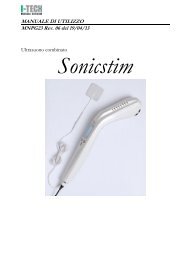MNPG05-09 - I-Tech Medical Division
MNPG05-09 - I-Tech Medical Division
MNPG05-09 - I-Tech Medical Division
Create successful ePaper yourself
Turn your PDF publications into a flip-book with our unique Google optimized e-Paper software.
2. Lipolysis/drainage impulse: the “pump” effect is produced by sequential tonic<br />
contractions. The intensity must be enough to produce these contractions: the greater the<br />
contraction is, the greater the pump effect will be. But beware: there is no benefit to be<br />
gained from enduring intensity high enough to cause pain. The first electrostimulation<br />
sessions should be carried out at a low intensity to allow the organism to get used to new<br />
sensations. That way intensity can be increased gradually and will not be traumatic.<br />
3. Warming-up impulse: stimulation intensity must be increased gradually to improve the<br />
metabolism of the muscle concerned progressively. A bit like with a car: the engine needs<br />
warming-up before it is taken to full speed.<br />
4. Toning, training, atrophy contraction impulse: the muscle treated must visibly contract<br />
during a training impulse. The fact that the muscle tends to stiffen and increase in volume<br />
will be visible. Intensity should be increased gradually (in the first contraction) to enable<br />
you to identify the right level of stimulation comfort. Intensity can be increased up to the<br />
personal tolerance threshold during the second training contraction; this operation is then<br />
repeated during each contraction until the workload reaches the level of intensity<br />
recommended in the description of the single programs. We recommend that you record<br />
the level of intensity reached in order to improve the level of stimulation and consequently<br />
your performance.<br />
5. Massage, winding down, active recovery impulse: intensity must be adjusted<br />
gradually to massage the muscle treated. The level of intensity should be sufficient to<br />
obtain a comfortable massage. There is no need to endure high intensity levels in this<br />
case as it is meant to be a massage, meaning that intensity can be increased gradually<br />
without excesses.<br />
6. Capillarization impulse: increase the intensity gradually to produce constant, visible<br />
stimulation of the area treated; a medium stimulation threshold is recommended, always<br />
below the pain threshold.<br />
11. Sports programs.<br />
IMPORTANT. Stimulation intensity: the sports programs (Resistance, Strength,<br />
Agonist/Antagonist) are divided into warm up phases, work phases, and recovery phases.<br />
During the warm up phase (phase 1), the stimulation intensity should be adjusted to produce a<br />
slight tickling sensation in the treated muscle, this should be enough to warm up the muscle<br />
without tiring it (18÷30 mA). During the work phases (the central phases of the programs),<br />
contraction impulses are alternated with active recovery impulses. The user needs to select<br />
the two intensities separately: for the contraction, the user should see the following on the<br />
display with a bold bar; 20÷30 mA for relatively unfit people, 30÷50 mA for fit people, and more<br />
than 50 mA for very fit people.<br />
We recommend adjusting the intensity of the recovery phase between one contraction and<br />
another by approximately 15÷20% less than the intensity of the contraction. During the<br />
recovery phase (the last phase), the intensity should be adjusted to produce a good<br />
massaging effect of the stimulated area without producing any pain (18÷30 mA).<br />
S01 • Warming up (all muscle groups).<br />
Program suitable for use before training sessions or competitions, very useful for sports<br />
involving maximum effort right from the start. Program duration: 28 minutes. Position of<br />
electrodes from photo 1 to photo 20. Recommended stimulation intensity: medium (20-<br />
30mA); the muscle must work without strain.<br />
IACER SRL <strong>MNPG05</strong>-<strong>09</strong> Ed. 26/04/11 Pag. 38




